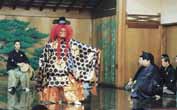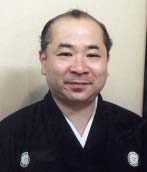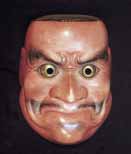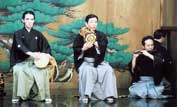People
Noh Theatre, a classic alive

The history of Noh Theatre goes back to the 8th century. A quantum jump was achieved by Kan-ami (1333-1384) and his son Ze-ami (1364?-1443) under the patronage of General Yoshimitu ASHIKAGA (1358-1408). Suddenly, the play became a theatrical art for highly sophisticated audiences. Ze-ami wrote a famous Noh textbook,"Kadensho" (1413). Now in the 21st century, the book still stands as an inspiring textbook for theater directors. Many say that Noh has been left unchanged for the last 600 years because it reached such a high level of sophistication in the early years. I think the reason Noh survived through the long history of social (sometimes violent) changes is not only because of this; it is the strong will of the whole society of Noh players, who have been working towards perfection over centuries. Noh society kept it as family business, so that they can work through many generations to improve the art.
A family that takes the role of "Shite-kata" (hero) stays as a "Shitekata" family; a family that takes supporting roles, "Wakikata", remains as a "Waki-kata" family and a family that plays musical instruments stays as a "Hayashi-kata" family forever.

The picture on the right shows Mr. Nobushige KAWAMURA of one of the major "Shite-kata" families. He started his childhood on the Noh stage and continued playing for almost 40 years. He has been very active in keeping the public recognition on Noh through teaching in a university and many other places in addition to performing Noh himself. His group has been performing in many places in Japan, as well as Paris, New York, Milan and Rome. Most Japanese would consider Noh players to be someone out of reach, mainly due to their highly respected status.
On the contrary, Mr. Kawamura is a very kind and friendly person although he would appear awesome on the Noh stage. It is the people, like Mr. Kawamura, who kept the Noh Theatre alive as one of the modern play style of the time. Noh will never be a play of the past; it is fully alive.
Noh stands out as one of the most impressive theatrical arts in the world.

The costume Noh players wear is of superlative design and quality and the masks they wear bear hundreds of years of history. It is as if the Noh masks have their own will to keep appearing on stage. Some masks are over 600 years old and still used. Although there is no provision to move any parts of it, a Noh mask can express every kind of emotion, thanks to the great talent of Noh players. Enclosed in the costume and the mask, a Noh player can become anything, often a ghost, a spirit or a god.
In almost any play in which a ghost plays a major role, audiences know that in it is a human that is playing the role of a ghost on stage.
In Noh, a good player will make you feel that you are really seeing a ghost. Behind the costume and the mask, the sense of a human being inside magically disappears. In well made movies where the directors can use all sorts of modern tricks, audiences can also be lead to believe that the super being exists. But I have never seen this magic happen on theater stages except in Noh plays, where the stage is only 5.4 meters wide and 5.4 meters deep. The first picture shows Mr. KAWAMURA in the "U-kai" play, where musicians and singers are visible behind the players. Neither stage settings (of any significance) nor lighting techniques are employed. Despite this, you will be lead into the scenery as if you were there. It is like a daydream.

Music in Noh is also extraordinary and is just like listening to an excellent performance of jazz. Each player feels the on-going rhythm and improvises the exact timing they should apply. Sprit seconds counts. It is amazing to know that there is no practice session prior to a performance except for some discussion between the performers.
While the music is going on, a Noh player will display an elegant dance called "Mai", while occasionally reciting a poem. It is like listening to a the softest passage of a masterpiece of music, where the music is at the highest spiritual point. The temperate movement of a Noh dance could show awesome solemnity or deep sorrow as well as the aggressive emotionof a flamenco dance. The energy on stage is sometimes so tense, you might hold your breath. Well, will you believe me? I can only say that seeing is believing. I should also mention a comic Kyogen play that often is associated with Noh plays, but I have no space for it here. (T.K.O.)
